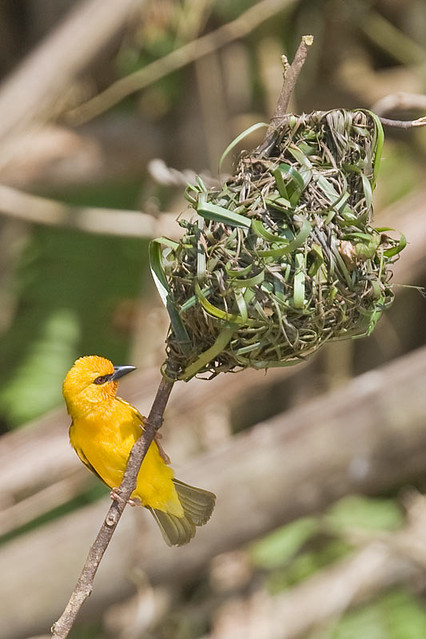Cladus: Eukaryota Name Ploceus aurantius (Vieillot, 1805) Vernacular names Reference Histoire naturelle des plus beaux oiseaux chanteur de la zone torride p.73 pl.XLIV
The Orange Weaver (Ploceus aurantius) is a species of bird in the Ploceidae family. It is found in Angola, Cameroon, Central African Republic, Republic of the Congo, Democratic Republic of the Congo, Ivory Coast, Equatorial Guinea, Gabon, Ghana, Kenya, Liberia, Nigeria, Sierra Leone, Tanzania, Togo, and Uganda. They are also commonly kept in aviculture. Appearance These birds exhibit sexual dimorphism, and plumage also varies seasonally. During breeding or "nuptial" season, the male has a black beak, black plumage around the eyes, and brown wings, The rest of the plumage is a brilliant red to orange in color. Outside of breeding season, the males sport plumage that is considerably more drab, brown overall with some dark streaks and a cream-colored belly. The females have the same plumage year-round, which resembles that of the off-season males. The males of this species are often confused males of the species E. o. orix, more commonly known as the grenadier weaver, or red bishop. Behavior In the wild, orange weavers make their homes in reed beds close to the surface of water. True to its name, male orange weavers construct complexly woven nests during breeding season. These birds, like most other finches, are social, and enjoy the company of other finches. In captivity, if kept in a cage, they are very agitated. Aviculture The orange weaver is commonly kept in aviculture. They are quite hardy for small birds Like all finches, they should be kept in groups. They may be housed with other, larger finches, and will generally do well in this situation. However, individual orange weavers can become quite aggressive during breeding season. Because of this, the aggressive finches must sometimes be separated from the group. Orange weavers should be fed a diet that is a balanced mixture of small cereal seeds, fresh greens and some live foods, such as mealworms. Because of their active nature, these finches should be housed in large aviaries. Breeding Orange weavers are polygamous in the wild, and two or three females should generally be provided for each male. References * BirdLife International 2004. Ploceus aurantius. 2006 IUCN Red List of Threatened Species. Downloaded on 26 July 2007. Source: Wikipedia, Wikispecies: All text is available under the terms of the GNU Free Documentation License |
|

